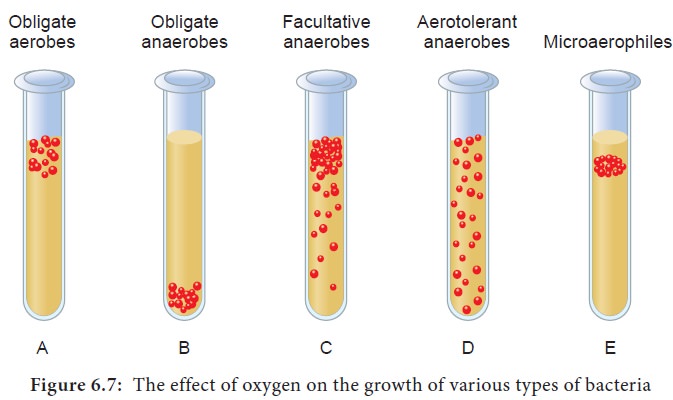Chapter: 11th Microbiology : Chapter 6 : Microbial Nutrition and Growth
Factors Influencing Microbial Growth
Factors Influencing Growth
The growth and activities of microorganisms are greatly
influenced by the physical and chemical conditions of their environment. Among
all factors, four key factors play major roles in controlling the growth of
microorganisms. They are
1. Temperature
2. pH
3. Water activity
4. Oxygen
1. Temperature
Temperature is one of the most important environmental factor
affecting the growth and survival of microorganisms. Temperature can affect
microorganisms because the enzyme catalysed reactions are sensitive to
fluctuations in temperature.
For every microorganism, there is a minimum temperature below
which no growth occurs, an optimum temperature at which growth is most rapid,
and a maximum temperature above which no growth occur. These three temperatures
are called cardinal temperatures.
Temperature classes of microorganisms
Microorganisms are broadly distinguished into four groups in
relation to their temperature optima.
·
Psychrophiles
·
Mesophiles
·
Thermophiles
·
Hyperthermophiles
Psychrophiles
A psychrophile can be defined as an organism with an optimal
growth temperature of 15°C, maximum growth temperature of 20°C and a minimum
growth temperature at 0°C. These organisms are found in polar regions like
Arctic and Antarctic oceans. They are rapidly killed as the temperature rises
because the cellular constituents start to leak due to cell membrane
disruption. Some examples of psychrophiles are Moritella, Photobacterium and Pseudomonas.
Psychrotolerant
Organisms that can grow at 0°C, but have temperature optimum
growth temperature range of 20°C-40°C are called psychrotolerant.
Mesophiles
These are microorganisms that grow in optimum temperature between 20-45°C, they have a temperature minimum of 15-20°C and a maximum temperature of 45°C. All human pathogens are mesophiles.
Thermophiles
Organisms whose growth temperature optimum is between 55-65°C
are called thermophiles. They have minimum growth temperature of 45°C. These
organisms are found in compost stacks, hot water lines and hot springs. They
contain enzymes that are heat stable and protein synthesis systems function
well at high temperature.
Hyperthermophiles
Organisms whose growth optimum temperature is above 80°C are called hyperthermophiles. These are mostly bacteria and archaebacteria. They are found in boiling hot springs and hydrothermal vents on seafloor.
2. pH
pH is defined as the negative logarithm of the hydrogen ion
concentration. pH scale extends from pH 0.0 to pH 14.0 and each exchange of 1
pH unit represents a 10 fold change in hydrogen ion concentration. pH greatly
influences microbial growth. Each organism has a definite pH range and well
defined pH growth optimum. Most natural environments have pH values between 5
and 9.
Organisms are classified into Acidophiles, Neutrophiles and
Alkalophiles based on their optimum growth pH.
Acidophiles are organisms that grow best at low pH (0.0–5.5)
Example: Most fungi, bacteria like Acidithiobacillus,
Archaebacteria like
Sulfolobus
and Thermoplasma.
Neutrophiles are organisms that grow well at an optimum pH
between 5.5 and 8.0. Most bacteria and protozoa are neutrophiles.
Organisms that prefer to grow at pH between 8.5-11.5 are called
alkalophiles. These microorganisms are typically found in soda lakes and high
carbonate soils. Example: Bacillus
firmus.
3. Water Activity and Osmosis
Water activity, (aw) is the ratio of vapour pressure
of the solution to the vapour pressure of pure water (aw values vary
between 0 and 1). Water activity is inversely related to osmotic pressure.
Organisms that can grow in low aw values are called osmotolerant.
Example: Staphylococus aureus.
Only a few organisms are capable of tolerating high salt
concentration and still growing optimally in low water activity. Such organisms
are called halophiles. Halophiles can grow in 1-15% Sodium chloride (NaCl)
concentrations. Organisms that can grow in very salty environments are called
extreme halophiles. (They can grow in 15-30%) NaCl concentration. Example: Halobacterium.
4. Oxygen
Most of the microorganisms require oxygen for their optimal
growth but some of them survive very well in total absence of oxygen and are
killed when exposed to air.
Based on their need and tolerance for oxygen, microorganisms are
classified into the following types.
1. Obligate aerobes exhibit growth only at full oxygen level (21% O2 on air) because O2
is needed for their respiration and metabolic activities Example: Micrococcus, most Algae, Fungi and
Protozoa.
2. Microaerophiles are aerobes that require oxygen at levels lower than that of air. Example: Azospirillum, Campylobacter, Treponema
3. Obligate anaerobes does not require oxygen for their respiration and growth. This group cannot
tolerate O2 and are killed in its presence. Example: Methanogens, Clostridium.
4. Aerotolerant anaerobes can grow in the presence of oxygen though O2 is not required
for their growth. Example: Streptococcus
pyogenes.
5. Facultative anaerobes can grow either under
oxic or anoxic conditions: Example: Escherichia
coli. (Figure 6.7)

Related Topics